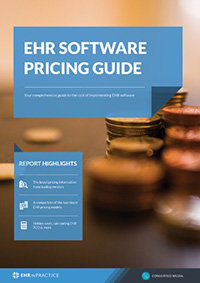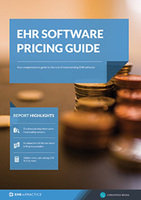How much EHR costs and how to set your budget
The cost of EHR is often one of the first questions organizations ask when selecting new software.
Implementing an EHR is a significant task, and it comes with a similar price tag. This article will break down the cost of an EHR implementation, how to budget, and what you can expect to pay for a system.
38% of healthcare CIOs listed ‘EMR optimization’ as their organization's top area of planned capital investment over the next three years. This is not surprising when most practices cited increasing efficiency as their top driving factor for implementing EHR in the first place, according to EHR report data.
Therefore, selecting and implementing an EHR system within budget has become a priority for many practices. Despite the demonstrated importance of EHRs in modern healthcare practice, a great deal of uncertainty exists as to how to properly understand the financial case for EHRs, or how to build an accurate and workable budget for system selection.
This guide will address issues related to EHR cost and constructing an EHR budget particularly:
- Justifying the cost of an EHR.
- Identifying the benefits of a new EHR
- Compiling EHR costs
- Creating an EHR budget
- Consider popular EHR systems pricing
We'll also look at the pricing of popular EHR systems. Let's start with the question on everyone's mind:
What is the cost of an EHR system?
A recent EHR report found that practices spend, on average, $1,200 per year per user on their EHR system. Larger practices benefit more from economies of scale with their average cost per user being only $685, in comparison to this recent research has shown it costs solo practices the most per user when paying for their EHR system. It's also important to note that a user isn't the same as a physician for the purposes of an EHR purchase - this includes support and admin staff who will need a user seat on the system to make bookings.
For a typical practice with 3 physicians and 4 support staff, you would expect to pay $8,400 for system costs alone. When you factor in training costs, data migration, and potential support payments if that isn't included in your plan - you're looking at spending over $10,000 each year - a significant investment.
How much does EHR maintenance cost?
On average, a study found that maintenance costs were $1,500 per physician per month - however, this should be taken with a grain of salt as the study was conducted over a decade ago when on-premise systems were the norm. Now that we are living in the cloud, the breakdown of maintenance costs is largely sat with your EHR vendor. Although, you should factor in support and training, as well as additional server costs, and the actual cost of running your IT department to maintain and ensure your data is secure.
1. Justifying the cost of implementing EHR
One of the major obstacles healthcare organizations face during EHR selection is uncertainty over whether the investment is justifiable, particularly if a practice is operating on thin margins.
First, and obviously, an EHR investment must fit into a practice’s existing short-term budget; however, one should not simply assume that the capital investment made into an EHR simply represents a regulatory requirement practice must fulfill. Rather, EHRs can provide significant benefits in the form of cost reductions when properly leveraged to:
- enhance service delivery
- reduce costs
- increase revenue
Accordingly, when making the case to justify the cost of an EHR investment the following strategies can be effective in creating buy-in from decision makers in your practice:
- A cost-benefit analysis focusing on specific elements of your practice such as quality of care, customer service or efficiency.
- An ROI forecast featuring short-term and long-term projections.
- An analysis that features the total cost of ownership in the short-term and long-term so that decision makers can be fully apprised of EHR-related costs
It is important to consider the key stakeholders in your EHR project including clinicians, administrative staff, board members, billing, and even your organization's marketing department. Your EHR stakeholders can make or break your EHR selection project, and having people in your organization who champion your software selection project can make a significant difference in the amount of funding your practice may receive.
2. Consider the benefits of EHR use
According to Health Affairs, practices can expect to cover the cost of EHR in approximately 2.5 years and then receive an average of approximately $23,000 per year per full-time employee in net benefits.
Considering these findings practices in various settings, sizes, and financial conditions can find some justification beyond simply complying with regulations.
Further evidence shows that when properly incorporated into a practice an EHR can provide an array of tangible benefits for a practice. The study outlined several areas in which an EHR can provide tangible benefits to a practice including:
- increased efficiency
- increased quality of care
- reduction of waste
- fewer medical errors
- better organizational outcomes (e.g., financial, and operational benefits)
- better societal outcomes (e.g., improved ability to conduct research, improved population health, reduced costs)
When viewed in light of these findings, the decision to invest in an EHR can be justified on metrics beyond simple financial benefit.
Despite a variety of clear evidence supporting EHR’s benefits, sorting out whether an investment in EHR can be justified can be a difficult task to undertake. This is because budgeting for EHR-related capital expenses and modeling return on investment for EHR can be a difficult and imprecise process if not engaged carefully.
When deciding whether to invest in an EHR a practice can rely on two tools:
ROI is a calculation of the most tangible financial gains or benefits that can be expected from a project versus the costs for implementing the EHR or suggested program or solution.
Use this EHR pricing guide to get accurate baseline prices for ROI calculations
An EHR Cost Benefit Analysis (CBA) is more comprehensive than ROI, and attempts to quantify both tangible and intangible costs and benefits. Whichever method a practice chooses, it is important to include all the direct and indirect costs that can impact the EHR investment.
3. Compile your EHR costs
Asking how much an EHR costs is the sort of general question that often results in an answer that begins with the phrase planners and project managers dread: “it depends.”
The answer to how much an EHR costs depends on what a practice is buying and for how long they intend to use it. Accordingly, it can be difficult to engage in an EHR price comparison without fully examining the variables that can affect the price of an EHR such as:
- the exact features a practice requires
- add-ons such as practice management or patient portal
- cloud or on premises deployment
- updating hardware to support the system
- the scale of the installation
With the goal of creating a comprehensive model of costs, the cost of an EHR should be expressed in terms of not just the “out of the box” price, rather in terms of long-term and comprehensive cost estimates.
Recent EHR research found that the average budget per user for an EHR software is $6,000. Solo practices spent more on their software compared to larger practices.
One of the most comprehensive and efficient measures for modeling long-term costs involves calculating the total cost of ownership (TCO). TCO is defined as a full assessment of information technology and services costs over time, representing an accounting of all costs (both short term and long term, and direct and indirect).
To illustrate, the following chart provides estimated average upfront cost, yearly cost, and five year total cost of ownership total cost of ownership for for on-site and SaaS EHR deployment. However, it is important to note that costs may vary based on the size of your practice and the features you want.
| Upfront cost | Yearly cost | 5 year TCO | |
|---|---|---|---|
| Cloud EHR | $26,000 | $8,000 | $58,000 |
| On-premise EHR | $33,000 | $4,000 | $48,000 |
(Source: Michigan Center for Effective IT Adoption)
Although most organizations can pin down basic EHR-related cost estimates, TCO calculations are subject to variance based on the factors outlined above.
Choosing your EHR deployment method (cloud vs on-premise) and factoring in associated costs
Furthermore, the cost of an EHR over the long-term can also vary according to the method of software deployment.
As illustrated above, the five-year TCO for on-premise and cloud-based systems show that the cloud-based option cost $58,000 while the office-based option cost practices $48,000. Upfront costs for the cloud-based system were less at $26,000 while the office-based system showed up-front costs of $33,000.
However, when looking beyond the TCO of a cloud or on-premises system the number of factors such as reliability, the hardware investment, EHR maintenance cost, and security all factor heavily in overall cost estimates not reflected in the study above.
In addition to TCO estimates, practices should also be aware of implementation costs, related to setting up and launching an EHR:
What is the cost of a top EMR/EHR software implementation?
Implementation costs vary according to context and the implementation plan, as such it is difficult to provide an average cost of EHR implementation.
However, case-specific examples can offer some insight with regard to implementation costs. For example, the Health Affairs study cited above found that a typical multi-physician practice would spend about $162,000 to implement an EHR, with $85,500 for first-year maintenance costs.
They also estimated that the implementation teams spent approximately 611 hours "preparing for and implementing" the EHR system. Whereas according to a Medical Economics study of thirty primary care practices, the average spend was $5,900 on purchases related to hardware, software, peripherals, and network connections and about half of the practices averaged $3,094 for "IT and other outside support" costs.
The average cost of hospital EHR implementation would be higher given the larger scale. Estimates show that these costs vary widely for community hospitals, according to a survey from Community Hospital 100 and Anthelio, with some organizations paying less than $5 million and others more than $20 million to implement an EHR.
What are the hidden costs of an EHR implementation?
When engaging in an EHR implementation cost breakdown it is important to consider that implementation budgets should include direct costs such as:
- software licensing
- projected maintenance
- consulting and training fees
- labor including overtime
- hardware (if required - usually only required for on-premise installations)
Further, it is important to also consider indirect costs such as:
- decreased revenue
- lost productivity
- decreased patient visits
When quantified, these can have a significant impact on how an implementation impacts the overall EHR budget.
For more on EHR implementation, check out our step-by-step EHR implementation whitepaper
Cost, incentives, and deciding which EHR features you need
When considering the types of features needed you should determine which features can best further organizational goals. If your practice currently participates in the Meaningful Use program, your new EHR’s features will need to ensure that a practice continues to qualify for incentive payments over the long term.
Get ideas for new EHR features using this guide to 40 features to look for in your next EHR
Incentive payments for eligible professionals who demonstrate meaningful use of certified EHR technology can reach up to $43,720 under Medicare over five consecutive years and under the Medicaid EHR Incentive Payments.
Eligible professionals who do not successfully demonstrate Meaningful Use will be subject to a downward adjustment to payments for covered professional services.
4. Compile costs into a complete EHR budget
The process of budgeting for an EHR differs from constructing a practice’s normal operating budget. An EHR budget contains several uncertainties that, if not taken into account, can result in costly mistakes.
However, when approached in a methodical manner that considers all potential contingencies, the risk of problems arising from a flawed budget can be reduced significantly. An EHR budget should contain, at a minimum the following components:
- Hardware: servers, computers, printers, scanners, and other peripherals.
- EHR software: all software costs including, additions and upgrades.
- Assistance: IT contractors, legal support, system maintenance and installation consulting support; data conversion, and workflow redesign support.
- Training: initial and ongoing training for clinical staff and office staff.
- Contingencies: potential productivity, revenue, and patient-related gains and losses.
5. Pricing of popular EHR systems
The cost of popular EHR systems varies based on the system’s application, its deployment, and whether any add-on features are included in the software package. In addition to these factors, pricing may vary according to whether the system is being purchased or leased or whether the software has a licensing structure whereby the price increases as more users or volume of data is processed through the system.
Given this variance in pricing, EHR cost can be a difficult line in a budget to forecast. Further complicating matters is the fact that that pricing information is not generally published online.
Therefore, if one is trying to obtain a broad overview of pricing for systems that may be considered during the selection process the request for information/request for proposal process will need to be used.
Despite the fact information regarding EHR software cost must be obtained during the request for information and request for proposal process a practice can still assemble a reliable and comprehensive cost estimate for systems that are under consideration in the selection process.
How much does Epic cost?
EPIC: Epic focuses on serving larger organizations such as health systems and hospitals. Epic's pricing starts at $1,200.00 for their self-hosted solutions, and $500,000 for large clinics and hospitals. Epic does not offer a free trial; however, it does provide a free demo presented by the vendor’s sales representatives.
How much does Cerner cost?
CERNER: Cerner represents the largest EHR vendor for inpatient providers and serves a wide range of ambulatory providers. Cerner offers both cloud-based and on-premise deployment options. Cerner’s product range includes over 50 specialty-focused products. Information collected from various online sources indicates that Cerner’s cloud-based service begins at $25 per month and increases with more advanced systems and with the more expensive on-premise deployment. Cerner does not offer a free trial.
How much does CareCloud cost?
CARECLOUD: CareCloud offers EHR, Practice Management, Revenue Cycle Management, and Patient Experience Management software. This cloud-based service primarily serves the ambulatory market. Pricing for the EHR begins at $349.00 with add-ons costing extra. Carecloud does not offer a free trial, however, it does provide a free demo presented by the vendor’s sales representatives.
How much does eClinicalWorks cost?
ECLINICALWORKS: eClinicalWorks offers an EHR, practice management software, patient engagement, ACOs and PCMH tools, care coordination, and population health management tools. The EHR solution costs $449 per month, the EHR with practice management costs $599 per month. The company’s revenue cycle management system is priced as a percentage of total billing (currently 2.9% of collections). Pricing information is available on the company’s website. eClinicalWorks does not offer a free trial.
How much does Allscripts cost?
ALLSCRIPTS: Allscripts’s open and connected health platform is primarily marketed to medium to small physician practices. Allscripts Choices, choices Allscripts offers an entire family of products, that include an EHR, revenue cycle solution with analytics, and a population health platform. Allscripts does not provide public pricing information. Rather potential users must contact the company to obtain pricing information. What is known from public information is that Allscripts does not offer a free trial and has a wide variety of pricing levels given the different combinations of features and products available.
This guide should give you a thorough overview on the cost of EHR, and give you an idea of how to estimate your expected budget for your project.
Free white paper

EHR Pricing Guide
Get your complete guide to EHR software pricing and project costs. Your headstart on EHR pricing research

Featured white papers
Related articles
-

EHR Implementation Plan: Your 8-Step Checklist
Your comprehensive checklist for creating an EHR implementation plan.
-

A template for your EHR project implementation timeline
Determining your EHR project timeline will prove tricky, but having some expectations of time fra...
-

Three factors you should consider when creating an EHR budget
When creating a budget for your EHR project, don't forget to take these 3 things into account.



